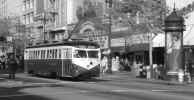The attack of the killer streetcar

may 8, 2000. Many authors over the years have written credibly
about what could have been a conspiracy by big
companies like General Motors and Firestone to rid
American cities of street cars and replace then with
diesel buses ó an interim step towards the complete
transformation into an auto nation. Toby Wiggin of
the Castro Neighborhood Council has a new streetcar
theory and chose to explain it in the last issue of
the San Francisco Call. It turns out the colorful
streetcars that roll up and down Market Street ó the
same ones others say the huge corporations tried so
hard to get rid of ó are an evil Trojan horse thatís
convincing San Franciscans to sell out to the likes of
Pottery Barn. The streetcars, itís claimed, are not
for residents, rather for tourists who will use them
to bring unwanted tourist dollars into the Castro. To
bolster the position, Wiggin says rents and evictions
are up and residents are moving away.
Make no mention that tourists by their nature have
no need for housing.
But perhaps itís the commercial rents. With local
stores, many of which verge on being porn shops, being
replaced by Pottery Barn and Banana Republic, it could
be the streetcars are giving tourists access to the
same stores they find closer to home in Peoria or
Pittsburgh.
Or could it be the huge market selling furniture
and kitchen accessories to tourists?
I live in the Castro, where many neighbors who hadnít
been to Fishermanís Wharf in decades say the
streetcars made it accessible to them. The tracks go
both ways.
The Pottery Barn that is moving in isnít the
first line in an army of neighborhood-destroying chain
stores opponents make it out to be. Like it or not, itís
coming because people in the neighborhood, not
tourists, like to shop there. And itís one of many
chains that have moved in, and even back out, of the
neighborhood.
But people in the neighborhood also use the
streetcars to get to work. I often go on rides just to
see the city, and meet the few tourists who actually
ride past Powell Street ó few of whom have been seen
carrying furniture back to their hotel rooms.
Every neighborhood in San Francisco is changing.
The Castro is changing because the population is
becoming older and more wealthy. Stores like Pottery
Barn reflect that.
On one streetcar thereís a tale spelled out about
a worker who a quarter-century ago persuaded his
bosses not to scrap one of the last remaining wooden
cars. He saved all the seats in his basement for
twenty-five years. Today, thanks to him, the car has
been restored and is running again. Is he part of this
evil plot?
The streetcars are a wonderful and unique part of
San Francisco put forth not by city politicos and
bureaucrats, but by a dedicated group of individuals
and volunteers ó long-time San Franciscans ó who
saw potential in preserving and restoring what other
cities discarded.
The streetcars are not the result of government
officials chasing tourist dollars, but an uphill
battle against the powers that be who wished to
destroy what is unique and replace it with freeways
and diesel buses.
No, theyíre not modern urban transportation. But
the low-rise Victorians in the Castro are not modern
high-rise apartment buildings. The streetcars are not
noisy, smelly, jerking diesel buses, and theyíre not
dark subways. They are a nice, clean, colorful,
nostalgic and interesting way to get around. And most
important, the streetcars work when everything else
doesnít.
The streetcars are good for Castro residents and
tourists.
Eric Miller is the editor of the New Colonist (www.newcolonist.com)